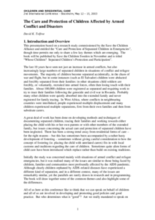The last 10 years have seen not just an increase in armed conflicts, but also increasingly large numbers of separated children in situations of conflict and refugee movements. The majority of children become separated accidentally, in the chaos of war and flight, but in some instances (such as El Salvador) children were abducted and forcibly separated from their families: in other situations child soldiers are forcibly, or voluntarily, recruited into armed forces, often then losing touch with their families. About 100,000 children were registered as separated and requiring work to try to trace their families following the genocide and civil war in Rwanda. Probably many other children were quietly absorbed into the extended family and never registered for family tracing. In West Africa, where conflicts in neighboring countries were interlinked, people experienced multiple displacement and many children experienced multiple separations, first from their own families and then from substitute carers.
A great deal of work has been done on developing methods and techniques of documenting separated children, tracing their families and working towards either placing the child with his or her own parents or with other members of the extended family, but issues concerning the actual care and protection of separated children have been neglected. There has been a strong trend away from residential forms of care – for the right reasons – but this has sometimes been accompanied by a rather hasty development of fostering – sometimes without giving careful consideration to how the concept of fostering (i.e. placing the child with unrelated carers) fits in with local customs and traditions regarding the care of children. Sometimes quite alien forms of child care have been introduced which replace rather than build on existing traditions.
Initially the study was concerned mainly with situations of armed conflict and refugee emergencies, but it was realized many of the issues are similar to those being faced by children, families and communities most profoundly affected by the AIDS pandemic. Although clearly children orphaned by AIDS-related diseases have experienced a different kind of separation, and in a different context, many of the issues are remarkably similar, yet the parallels are rarely drawn in research and in programming. The book will draw together some of the common themes and also highlight some of the differences.
©From: The 2003 Stockholm Conference on Residential Care. No copyright details.

